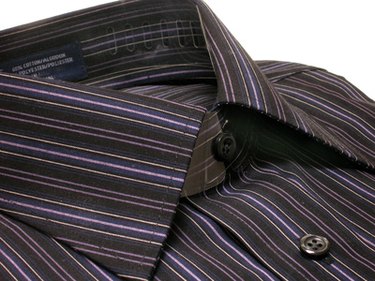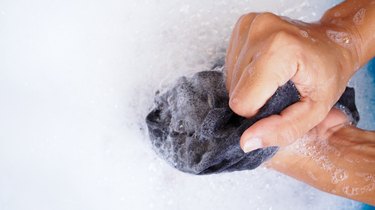
It's all too easy to get Wite-Out on oneself while using the substance at home, work or school. It can take a while for it to flake off and wash away from your skin; after all, it was designed to last. Eventually, though, Wite-Out can be removed from your hands. When you get Wite-Out on your clothes, however, the stains can be harder to remove. Fortunately, there are some tricks that can help you to remove these stubborn stains.
Removing Wite-Out on Clothes
Video of the Day
When you get Wite-Out on clothes, it bonds to the fabric and hardens. To get this white substance off your clothing, you will need a dull knife, WD-40, glass cleaner, acetone, mild soap, a sponge, soft cloths and water. Put on a pair of protective gloves and scrape away as much Wite-Out from the fabric as you can with a dull knife.
Video of the Day
Apply WD-40 or glass cleaner to both sides of the stain and gently rub with your gloved fingers. Let it sit for several minutes and scrub with a damp sponge or cloth. Rinse with clean water and see if there is any stain left. If there is, put a clean cloth under the stained area and blot the front and back with acetone. Clean with mild soap and water. Do not dry the clothing until you are sure that the stain is gone for good.

Other experts recommend using an adhesive remover, like Goo Gone or rubbing alcohol, to get rid of Wite-Out stains on clothing. Just be extra careful since some chemicals can actually make Wite-Out stains worse. Other chemicals may remove Wite-Out on clothes but can destroy the fabric in the process.
Removing Wite-Out From Other Surfaces
You can use the same methods to also remove Wite-Out from upholstery and carpet but be sure to test it on a hidden area first. If the stain is large and you are afraid to try acetone or another chemical, it is best to call a professional cleaner. You wouldn't want to ruin expensive carpeting or furniture.
To get Wite-Out off wood with a polyurethane or varnish finish, try blotting at the stain with a sponge, taking care not to spread it. If it has dried, use a dull knife or credit card to first scrape away as much of the stain as you can.
Dampen a soft cloth with a little bit of alcohol and carefully wipe at the stain, working with the wood grain. Keep wiping with a little bit of alcohol at a time and the stain should come out. You can also try sanding it out with some fine-grained sandpaper.
What Is in Wite-Out?
"Wite-Out" is the brand name for a correction fluid that is painted on to correct written, typed or printed errors on paper. It is often generally called "White Out." This liquid is made from titanium dioxide, petroleum, light aliphatic and petroleum. These are the active chemicals, and mineral spirits, resin, dispersant, fragrance and colorants are added to create the white substance.

The product "Liquid Paper" preceded "Wite-Out" and was invented by Betty Nesmith Graham in 1951 as a paint that could cover errors. She sold this to the Gillette Corporation 28 years later, and it was christened "Liquid Paper." However, critics found it to be carcinogenic after studies linked it to fatalities. The toxic chemical ingredient in question (trichloroethane) was removed, and the formula was changed and became safer. Wite-Out is Liquid Paper's chief competitor.